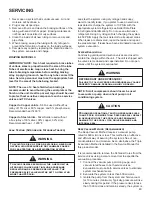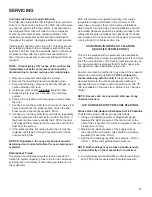
SERVICING
48
1. Never open a system that is under vacuum. Air and
moisture will be drawn in.
2. Plug or cap all openings.
3. Remove all burrs and clean the brazing surfaces of the
tubing with sand cloth or paper. Brazing materials do
not flow well on oxidized or oily surfaces.
4. Clean the inside of all new tubing to remove oils and
pipe chips.
5. When brazing, sweep the tubing with dry nitrogen to
prevent the formation of oxides on the inside surfaces.
6. Complete any repair by replacing the liquid line drier in
the system, evacuate and charge.
BRAZING MATERIALS
IMPORTANT NOTE:
Torch heat required to braze tubes
of various sizes is proportional to the size of the tube.
Tubes of smaller size require less heat to bring the
tube to brazing temperature before adding brazing
alloy. Applying too much heat to any tube can melt the
tube. Service personnel must use the appropriate heat
level for the size of the tube being brazed.
NOTE: The use of a heat shield when brazing is
recommended to avoid burning the serial plate or the
finish on the unit. Heat trap or wet rags should be used
to protect heat sensitive components such as service
valves and TXV valves.
Copper to Copper Joints
- Sil-Fos used without flux
(alloy of 15% silver, 80% copper, and 5% phosphorous).
Recommended heat 1400°F.
Copper to Steel Joints
- Silver Solder used without
a flux (alloy of 30% silver, 38% copper, 32% zinc).
Recommended heat - 1200°F.
Leak Testing (Nitrogen or Nitrogen-Traced)
WARNING
To avoid the risk of fire or explosion, never use
oxygen, high pressure air or flammable gases
for leak testing of a refrigeration system.
WARNING
To avoid possible explosion, the line from the
nitrogen cylinder must include a pressure
regulator and a pressure relief valve. The
pressure relief valve must be set to open at no
more than 450 psig.
Leak test the system using dry nitrogen and soapy
water to identify leaks. If you prefer to use an electronic
leak detector, charge the system to 10 PSIG with the
appropriate system refrigerant (see Serial Data Plate
for refrigerant identification). Do not use an alternative
refrigerant. Using dry nitrogen finish charging the system
to 450 PSIG. Apply the leak detector to all suspect areas.
When leaks are discovered, repair the leaks, and repeat
the pressure test. If leaks have been eliminated proceed to
system evacuation.
System Evacuation
Condensing unit liquid and suction valves are closed to
contain the charge within the unit. The unit is shipped with
the valve stems closed and caps installed. Do not open
valves until the system is evacuated.
WARNING
REFRIGERANT UNDER PRESSURE!
Failure to follow proper procedures may cause
property damage, personal injury or death.
NOTE: Scroll compressors should never be used
to evacuate or pump down a heat pump or air
conditioning system.
CAUTION
Prolonged operation at suction pressures less
than 20 psig for more than 5 seconds will result
in overheating of the scrolls and permanent
damage to the scroll tips, drive bearings and
internal seal.
Deep Vacuum Method (Recommended)
The Deep Vacuum Method requires a vacuum pump
rated for 500 microns or less. This method is an effective
and efficient way of assuring the system is free of non-
condensable air and moisture. As an alternative, the Triple
Evacuation Method is detailed in the Service Manual for
this product model.
It is recommended to remove the Schrader Cores from the
service valves using a core-removal tool to expedite the
evacuation procedure.
1. Connect the vacuum pump, micron gauge, and
vacuum rated hoses to both service valves.
Evacuation must use both service valves to eliminate
system mechanical seals.
2. Evacuate the system to less than 500 microns.
3. Isolate the pump from the system and hold vacuum
for 10 minutes (minimum). Typically, pressure will rise
slowly during this period. If the pressure rises to less
than 1000 microns and remains steady, the system is
Summary of Contents for ASXC16
Page 4: ...PRODUCT IDENTIFICATION 4 ...
Page 5: ...PRODUCT IDENTIFICATION 5 ...
















































